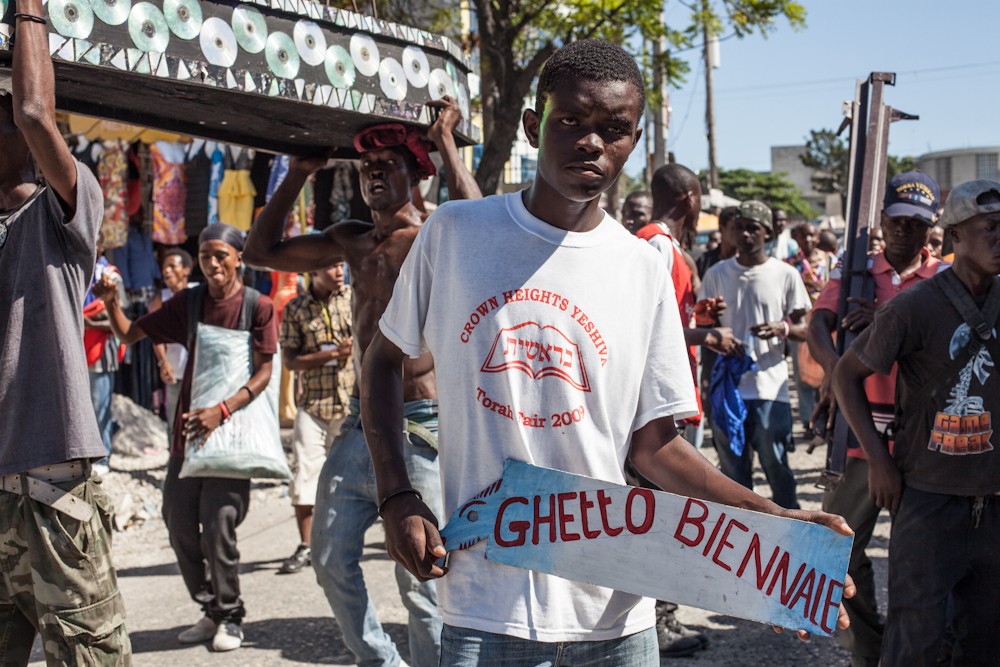
The Third Ghetto Biennale, Port-au-Prince, Haiti, 2013
From Haiti’s Ghetto Biennale to Minnesota’s Art Shanty Projects, a floating school in Lagos to Pittsburgh’s Conflict Kitchen, 32 global projects have been shortlisted for the 2015 International Award for Public Art, which “honors excellence in the field of public art, increases visibility for public art internationally, and fosters knowledge through research, discussion, and debate.” All selected projects will be presented in an exhibition, publication, and the online platform Public Art Archive in 2015.
- Among her three wishes for the new year the LA Times’s Carolina Miranda includes development of a major biennial—Hammer in 2016? Whitney in 2017?—dedicated not to “squishy non-themes about questions of process and time and hybridity” but to race: “Barring a few exceptions, the art world has an aversion to work that addresses questions of race, class and gender, often dismissing it as identity art. Well, ‘identity’ is now on the social and political front-burner. It’s time for the art world to catch up.”
- What word could we use to describe banal market-driven abstract art created for a quick buck? Answer: “Crapstraction.” (Also known as “zombie formalism.”) The Art Newspaper rounds up seven art world terms that gained currency this year.
- Here at the Walker, we’ve been doing a year-end roundup of our own: we invited 19 artists, writers, curators, and filmmakers from around the world to share their top moments of 2014. Contributors include performance/video artist Kalup Linzy, Hüsker Dü drummer Grant Hart, poet LaTasha N. Nevada Diggs, artist Korakrit Arunanondchai, WIELS curator Devrim Bayar, designers Eric Hu and David Reinfurt, author Jeff Chang, and others.
- Afghans in the Bamiyan province have been restoring historic monuments destroyed by the Taliban following a 2001 decree that called for the destruction of “un-Islamic” images. The job has provided skilled workers with income and a sense of cultural pride. These landmarks “show that we have an ancient history full of ingenuity and talent that dates back hundreds of years,” one of the workers said. With foreign aid dwindling, Bamiyan governor Gen. Ghulam Ali Wahdat has appealed to potential donors by highlighting the restorations’ hopeful promise: “If they see development here, these [warring] people would return to their own provinces with a sense of why peace is important and what it can bring.”
- Christopher Knight explores the repercussions of charging admission to art museums, specifically its influence on programming: “Admission fees turn visitors into customers, and relying on customers turns an educational enterprise … into a public entertainment.” For example, contemporary museums may forgo efforts to provide a deeper understanding of contemporary art, instead turning to popular, household names like Andy Warhol to draw paying audiences.
- “Culture”—Merriam-Webster’s 2014 Word of the Year—was the most searched word of the year for the online dictionary. But what does it mean? “If anything, its value as a word depends on the tension between [its different definitions],” writes Joshua Rotham for the New Yorker. While using the term to describe various systems and identities make it confusing, “culture” represents “a wish that a group of people might discover, together, a good way of life; that their good way of life might express itself in their habits, institutions, and activities; and that those, in turn, might help individuals flourish in their own ways.”
Follow Art News From Elsewhere on the Walker Art Center homepage or via @walkermag, the Walker’s editorial-focused Twitter feed.